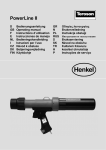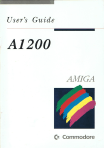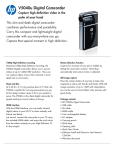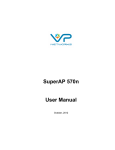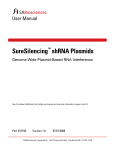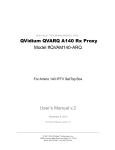Download user`s manual
Transcript
4MB PCMCIA SRAM User’s Manual Low cost Fast RAM expansion for Amiga 600/1200. September 11, 2014 Overview Thank you for purchasing Sakura 4MB PCMCIA SRAM expansion! This product has the following features: • Adds 4MB of Fast RAM to Amiga 600 or Amiga 1200. • Accelerates unexpanded Amiga 1200 to at least 1.67 MIPS (according to SysInfo). • Built using modern, high performance 55ns SRAM ICs. • Very simple installation - just insert the card into PCMCIA slot on the left side of Amiga. • Compatible with all PCMCIA friendly accelerators and memory expansions1 . • Open source design2 under CC-BY-SA (board) and MIT (CPLD core) licenses. • Made by Amigans for Amigans! Installation The installation process is very easy. To install the expansion perform the following steps: • Power down your Amiga. • Slide the expansion card into PCMCIA slot, located on the left side of your computer. The card’s components should be facing upwards. • Be sure the RAM/disk switch is in RAM position. • Turn on your Amiga and enjoy additional 4MB of memory. Your Amiga should start as normal, albeit a bit faster. After installation you can confirm that the board is working correctly, by checking amount of available memory on the Workbench top menu bar, or with the avail or ShowConfig commands. Popular SysInfo tool will report the additional 4MB of memory under card.resource name. 1 We did our best to ensure that this card works on as many configurations as possible, but some accelerator and Fast RAM expansion designs are inherently incompatible with PCMCIA slot if more than 4MB of memory is installed. Note that PCMCIA SRAM should work with them anyway, if less than 4MB Fast was installed on the turbo card. Of course, if you don’t have any accelerator, you don’t have to worry about that. 2 Visit the source code reposity: https://github.com/rkujawa/ppa-pcmcia-sram . 1 C8 0,1uF 1 74LCX541TTR C14 0,1uF C12 C9 0,1uF C7 74LCX245MTC C6 0,1uF IC2 74LCX245MTC FCI - 10014744-002SLF 0,1uF IC6 C10 0,1uF 0,1uF 0,1uF IC7 IC5 74LCX541TTR 74LCX541TTR 0,1uF IC3 C11 RAM/Disk 74LCX245MTC SW1 XC9536XL_44VQ IC8 C13 IC4 PCMCIA female X1 C5 0,1uF C3 6 JTAG AS6C3216-55 0,1uF 1uF/6,3V C2 C4 * 0,1uF TLV70033DDCT IC9 IC1 C1 1uF/6,3V Technical details SAKURA 4MB SRAM v2.1 Revision 2.x Sakura boards are built around Alliance Memory AS6C3216, which is a 55ns 32 megabit SRAM chip with 16-bit data bus. The memory is accessible within high 4MB of Zorro 2 memory (0x600000-0x9FFFFF) range. Control signals for SRAM are generated by Xilinx XC9536XL CPLD, based on PCMCIA slot access signals. This expansion is a completely autoconfiguring device. Memory is automatically added to the system memory pool by Kickstart. Autoconfiguration process is done according to the Card Information Structure (CIS) provided by the card, which is parsed by card.resource. Naturally, this process only takes place during system startup, so inserting card into Amiga when it is running does not cause memory to be added. If necessary it could be added manually with AddMem command (avaialble on aminet), although this is not required during normal operation. Sakura expansion CIS contains optimal settings that allow best possible PCMCIA slot peformance: • On Amiga 600 Gayle chip is configured for 570ns access time by default, which results in performance similar to Fast RAM expansions attached on top of 68000 CPU. • On Amiga 1200 the default configuration is 250ns access time, but Kickstart automatically reconfigures Gayle for 100ns access, according to CIS. This results in some performance increase compared to an unexpanded Amiga 1200. Contrary to popular opinions, Amiga 1200 equipped with high performance, correclty configured PCMCIA SRAM expansion (like this one) is performing better than Chip RAM only system. CIS ROM is also implemented within XC9536XL CPLD. Sakura expansion is electrically compatible with PCMCIA 2.1 standard, however physical dimensions of the card are smaller. While in theory this card should work with other devices, using it with computers other than Amiga 600/1200 was never tested and is discouraged. 2 Temporary disk mode It is possible to use the Sakura board as temporary virtual disk. To switch the board into this mode, take the following steps: • Turn off your Amiga and remove the Sakura board. • Set the RAM/disk switch into disk position. • Turn on your Amiga, instert the Sakura after booting into Workbench. • Run the PrepCard application. • Select Prepare as disk option. • After your card is successfully prepared, reboot the Amiga. • Notice the new volume named Empty on your Workbench screen. Enjoy your temporary 4MB storage. The card in this mode is handed by device CC0, which is provided by the Kickstart. Troubleshooting • Q: After powering up the Amiga, the memory does not appear on the Workbench bar and the output of ShowConfig command. • A: Check if the card is properly inserted into PCMCIA slot. Check if the RAM/Disk switch is in the RAM position. Reboot the Amiga. • Q: The memory is not automatially added to the system if Sakura card is inserted when Amiga is already powered on. • A: The probe procedure for PCMCIA memory is executed only during system startup. Reboot the Amiga to see the additional memory. • Q: PrepCard utility refuses to start, stating that memory is already configured. • A: It is not necessary to use PrepCard with Sakura board configured as RAM. Predefined CIS settings are selected with RAM/Disk switch. It is possible to view the current CIS settings by starting the PrepCard just after inserting the card into Amiga (i.e. before reboot). • Q: Performance of my Amiga 1200 dropped after installing the card. • A: Be sure that RAM/disk switch is in RAM position. If not then turn off your Amiga completely, wait a few seconds and set the switch in RAM position. After power-on you should notice considerable speedup. 3 Acknowledgements Sakura expansion was designed by Radoslaw ,,strim” Kujawa and Jaroslaw ,,jarob” Bieliński. The original idea was suggested on PPA.pl forum by RomanWorkshop. All schematics and board layout files are licensed under Creative Commons Attribution-ShareAlike 4.0 license. CPLD core source is licensed under MIT license. The card is made in Poland and conforms to RoHS standard. All new cards sold through our exclusive dealer, RetroAmi, are covered by 24 months warranty. Due to open source nature of the project, note that only cards produced by us (and therefore sold through RetroAmi) are covered by this warranty. In case of necessary service repairs please contact the shop directly. Do not attempt to repair the card yourself, it will void warranty. Do not remove the sticker on the back of the card - it contains serial number. Please save the invoice/bill as a proof of transaction. Thanks to everyone who preordered the board - you made this project happen! Contact In case of any questions/inquires please contact RetroAmi: http://retroami.com.pl/ 4






